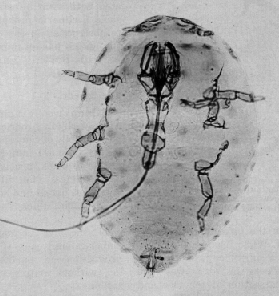Adelgidae
Adelgidae, commonly known as woolly aphids, are a family of insects in the order Hemiptera, which is known for comprising true bugs. This family is closely related to Aphididae, the family that includes many species of aphids familiar to gardeners and farmers due to their status as pests. Adelgidae are small, soft-bodied insects that feed on the sap of plants, particularly those of the Pinaceae family, which includes many types of coniferous trees.
Description[edit | edit source]
Members of the Adelgidae family are characterized by their woolly appearance, which is due to the secretion of a waxy, white substance that covers their bodies. This substance helps protect them from predators and environmental hazards. They are typically very small, with adults usually measuring less than 3 mm in length. Like other Hemipterans, they have piercing-sucking mouthparts which they use to extract sap from the host plant.
Life Cycle[edit | edit source]
The life cycle of Adelgidae can be quite complex, involving multiple host plants and different morphological forms across generations. Many species exhibit a form of alternation of generations, where they switch between sexual and asexual reproduction depending on the season or the host plant. Some species are known to be host-specific, only feeding on a single species of plant, while others can infest several different species within the Pinaceae family.
Ecology and Impact[edit | edit source]
Adelgidae play a significant role in their ecosystems, both as pests and as part of the food web. On one hand, they can cause significant damage to their host plants by depleting sap and transmitting plant diseases, which can lead to reduced growth and even death of the trees. This has economic implications, especially in forestry and Christmas tree farming. On the other hand, they serve as a food source for a variety of predators, including ladybugs, lacewings, and certain types of birds.
Management[edit | edit source]
Managing Adelgidae infestations involves a combination of cultural, biological, and chemical methods. Cultural practices include selecting resistant tree species for planting and proper spacing to reduce stress on the trees. Biological control involves the introduction of natural predators or parasites of the Adelgidae. Chemical control can be effective but must be used judiciously to avoid harming non-target species and the environment.
Notable Species[edit | edit source]
One of the most well-known species within this family is the Hemlock woolly adelgid (Adelges tsugae), which is a significant pest of hemlock trees in eastern North America. Another notable species is the balsam woolly adelgid (Adelges piceae), which affects fir trees and has been responsible for widespread tree mortality in affected areas.
Search WikiMD
Ad.Tired of being Overweight? Try W8MD's NYC physician weight loss.
Semaglutide (Ozempic / Wegovy and Tirzepatide (Mounjaro / Zepbound) available. Call 718 946 5500.
Advertise on WikiMD
|
WikiMD's Wellness Encyclopedia |
| Let Food Be Thy Medicine Medicine Thy Food - Hippocrates |
Translate this page: - East Asian
中文,
日本,
한국어,
South Asian
हिन्दी,
தமிழ்,
తెలుగు,
Urdu,
ಕನ್ನಡ,
Southeast Asian
Indonesian,
Vietnamese,
Thai,
မြန်မာဘာသာ,
বাংলা
European
español,
Deutsch,
français,
Greek,
português do Brasil,
polski,
română,
русский,
Nederlands,
norsk,
svenska,
suomi,
Italian
Middle Eastern & African
عربى,
Turkish,
Persian,
Hebrew,
Afrikaans,
isiZulu,
Kiswahili,
Other
Bulgarian,
Hungarian,
Czech,
Swedish,
മലയാളം,
मराठी,
ਪੰਜਾਬੀ,
ગુજરાતી,
Portuguese,
Ukrainian
Medical Disclaimer: WikiMD is not a substitute for professional medical advice. The information on WikiMD is provided as an information resource only, may be incorrect, outdated or misleading, and is not to be used or relied on for any diagnostic or treatment purposes. Please consult your health care provider before making any healthcare decisions or for guidance about a specific medical condition. WikiMD expressly disclaims responsibility, and shall have no liability, for any damages, loss, injury, or liability whatsoever suffered as a result of your reliance on the information contained in this site. By visiting this site you agree to the foregoing terms and conditions, which may from time to time be changed or supplemented by WikiMD. If you do not agree to the foregoing terms and conditions, you should not enter or use this site. See full disclaimer.
Credits:Most images are courtesy of Wikimedia commons, and templates, categories Wikipedia, licensed under CC BY SA or similar.
Contributors: Prab R. Tumpati, MD


